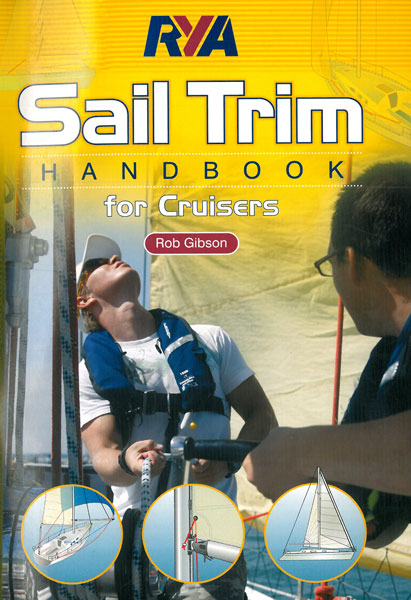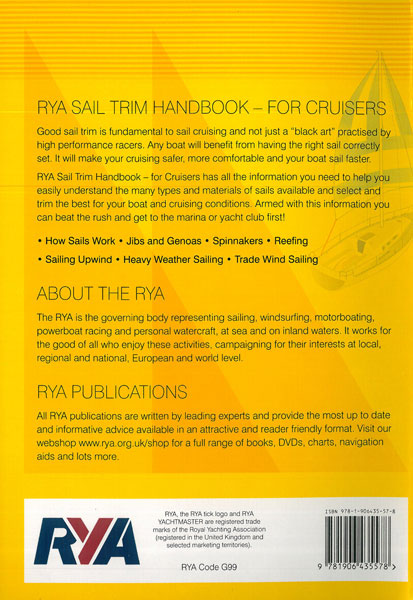Sail Trim Handbook - for Cruisers Справочник по триммеру парусов - для крейсерских яхт
As a sailmaker alf my working life and the founder in 1985 of Kemp Sails, sail trim is for me as natural as walking or riding a bike, but for many it can appear to be some kind of black art! When Rob asked me to write the foreword to his new book I was both honoured and excited at the prospect of introducing sail trim to new eyes.
Good sail trim is not just for high performance racers, any sailor will benefit from correctly set sails. Not only will the boat be more comfortable and safer, it will also sail faster as well. This may win you a regatta or a once a season race but it can just as easily get you into port before the tide changes, Imagine, there you are, sitting enjoying a well earned meal while your cruising companions are still out there slogging away, I know where I would like to be! Correct sail trim is not just about performance or winning races, sails are a complicated product that can take many hours to build, the materials range from a fairly robust Polyester to ultra light weight membranes incorporating the very latest composite fibres so whether you have just purchased a simple roller genoa, or the newest membrane mainsail, you need to protect your investment, I am all too aware of how much sails cost, but as a sailmaker I would like to see you look after them and use them properly.
All the information you need to know is here - I hope it inspires as much fascination in sail trim with you as with me when I was a small child sailing his Mirror dinghy. Just remember sail trim is like riding a bike, the more you do it the better you get and if you fall off, climb back on and try again,
FOREWORD
INTRODUCTION
1 HOW SAILS WORK
Flow theory
Some fundamentals
Beating
Beam reach
Balance
Weather helm
Lee helm
Apparent wind / true wind
2 RIG TYPES
Setting up the rig
Centring the mas
Adjusting the shroud
Pre-bend
Checking the rig under sail
3 JIBS & GENOAS
Foresails
Foresail controls
Roller reefing foresails
4 MAINSAILS
Mainsail controls
Trimming the mainsail
Fully battened mainsails
Lazy jacks
In-mast reefing mainsails
5 REEFING
Reefing a conventional mainsail
6 SAILING UPWIND
Acting as one
Sails - small but perfectly formed
Light airs (Force 1 to 2)
Medium wind (Force 3 to 4)
Heavy winds (Force 5 and above)
Target speeds
Up-wind VMG
Lee bowing the tide
Wind shifts and squalls
7 REACHING
Tracks and barber haulers
Reaching blocks
Whisker poles
Reaching sails
Hull speeds
8 DOWNWIND SAILING
Preventers
Poling out headsails
Roll control
Mainsail or no mainsail?
Training runs - tacking downwind
Downwind VMG
Using waves
Gusts
9 TRADE WIND SAILING
Twin Headsails
10 SPINNAKERS
Asymmetric spinnakers
Setting a gennaker
Hoisting
Trimming
Reaching
Running
Gybing
Dropping
Rollers
Bowsprits
Snuffers
Packing spinnakers
11 SYMMETRICAL SPINNAKERS
Setting up
Hoisting
Trimming
Gybing - dip pole method
Gybing - end to end method
Dropping - by the head
Dropping - tripping the windward clew
Broaching
12 SAILS AND SAILCLOTHS
Laminates
Woven sailcloths
UV Protection
Spinnakers and gennakers
13 HEAVY WEATHER SAILS
Heavy weather jib
Trysail
Storm jib
Waves and heavy weather
Storm sailing
Heaving to
GLOSSARY
Sailmakers' terms
INDEX
MEMBERSHIP PAGES




 Шкипер. Пособие по управлению яхтой
Шкипер. Пособие по управлению яхтой  Руководство по механическим и электрическим системам яхты. Том 2. Механические системы яхты
Руководство по механическим и электрическим системам яхты. Том 2. Механические системы яхты